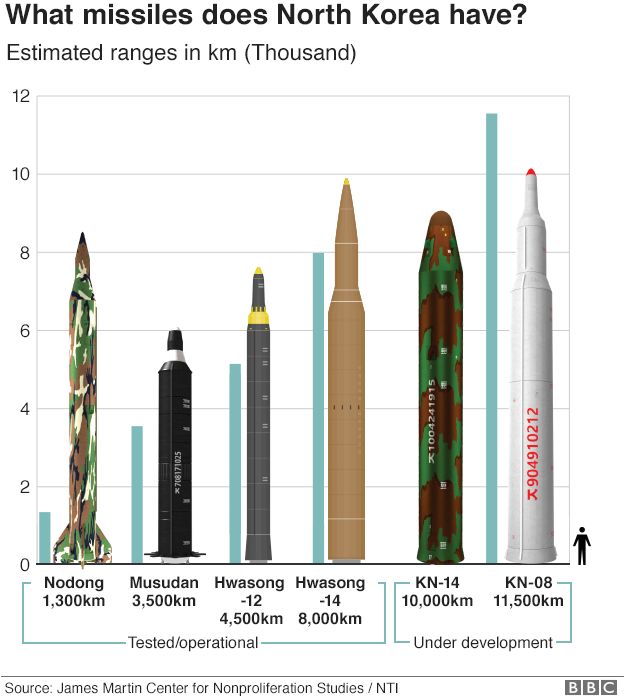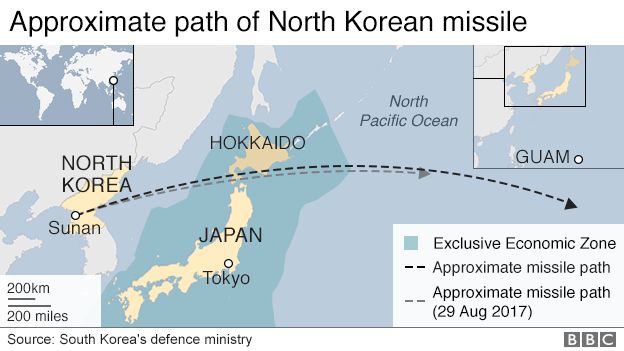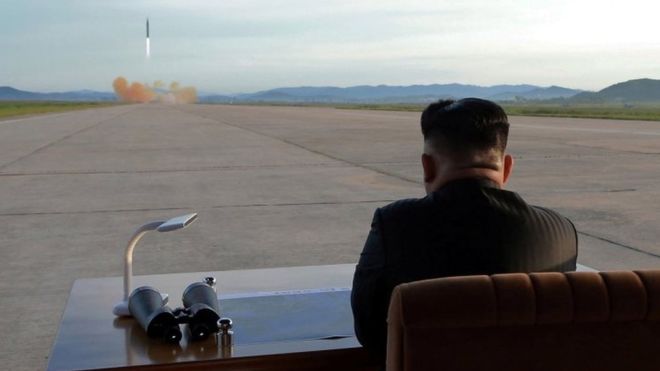
North Korea Will Reach Its Nuclear Force Goal – Kim Jong-Un
North Korean leader Kim Jong-un has vowed to reach the country’s nuclear goals, according to state media.
The aim was to establish “equilibrium” of military force with the US, the KCNA news agency quoted him as saying.
Mr Kim’s comments come after North Korea fired its latest missile over Japan – in what is being described as the country’s farthest-reaching test.
The move split world powers who united behind new UN sanctions against North Korea just days ago.
“We should clearly show the big power chauvinists how our state attain the goal of completing its nuclear force despite their limitless sanctions and blockade,” Mr Kim was quoted as saying by the KCNA.
He also said North Korea’s goal was “to establish the equilibrium of real force with the US and make the US rulers dare not talk about military option for the DPRK [North Korea]”.
-
Are missiles a risk to planes?
-
The weapons North Korea does not admit to
-
Three minutes to shelter from a missile
Mr Kim personally watched the launch of a Hwasong-12 ballistic missile on Friday.
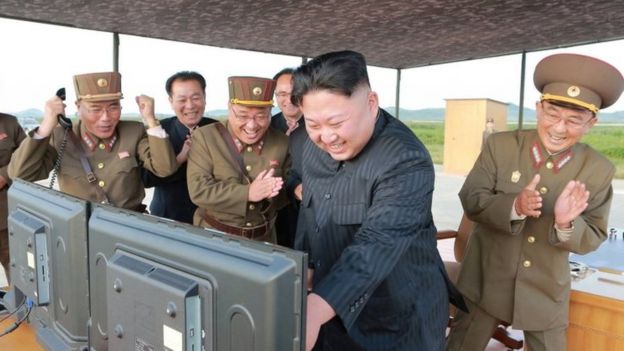 Image captionKim Jong-un and North Korea’s top military officials celebrated the launch
Image captionKim Jong-un and North Korea’s top military officials celebrated the launch
The missile reached an altitude of about 770km (478 miles), travelling 3,700km past the northernmost island of Hokkaido before landing in the sea, South Korea’s military said.
The missile had the capacity to reach the US territory of Guam and experts say it is the furthest any North Korean ballistic missile has ever travelled above ground.
How the world reacted to the test?

Media caption“I don’t know when I might be killed” – reaction to the latest missile launch
The UN Security Council convened an emergency meeting, in which members unanimously condemned the launch as “highly provocative” – coming as it did after Pyongyang’s nuclear bomb test on 3 September.
US President Donald Trump said North Korea had “once again shown its utter contempt for its neighbours, and the entire world community”, but that he felt more confident than ever that the US was ready should a military option be needed.
But Russia’s ambassador to the UN, Vasiliy Nebenzia, urged caution, saying: “We think that threats, tests, launches, and mutual threats in fact should be stopped, and that we should engage in meaningful negotiations.”
China accused the US of shirking its responsibilities.
“Honestly, I think the United States should be doing… much more than now, so that there’s real effective international co-operation on this issue”, China’s ambassador to the US, Cui Tiankai, was quoted as saying by Reuters.
“They should refrain from issuing more threats. They should do more to find effective ways to resume dialogue and negotiation,” he said.
United Nations sanctions – no more no less.
From a Chinese ambassador, that is blunt language and signals Beijing’s irritation over American pressure.
China feels it deserves more credit for the hard work and economic pain involved in enforcing two new rounds of UN sanctions within a matter of weeks. It also doubts that sanctions alone, however tough, will deter Pyongyang.
So Ambassador Cui Tiankai had his own advice for Washington, saying it should avoid making threats and instead resume dialogue.
The only satisfied party today is North Korea.
But China has insisted time and again that it will never accept North Korea as a nuclear weapons state, and it can’t avoid the obvious and urgent question: how does China intend to stop it?
No new sanctions have been announced at the Council’s meeting.
Why does this new test matter?
The launch took place from the Sunan district of the capital Pyongyang just before 07:00 local time on Friday (22:00 GMT on Thursday), South Korea’s military says. Sunan is home to Pyongyang International Airport.
As with the last test on 29 August, the missile flew over Japan’s Hokkaido island before splashing down in the Pacific Ocean.
Sirens sounded across the region and text message alerts were sent out warning people to take cover.
| Comparison of missile launches over Japan | ||
|---|---|---|
| 15 September | 29 August | |
| Distance travelled | 3,700km (2,299 miles) | 2,700km |
| Maximum altitude | 770km | 550km |
| Landing distance from Japan | 2,200km | 1,180km |
| Flight duration | 19 minutes | 32 minutes |
| Missile type | Thought to be intermediate range Hwasong-12 | Thought to be intermediate range Hwasong-12 |
What is so alarming about the new launch is that the US Pacific territory of Guam, which North Korea says it has a plan to target, is 3,400km from Pyongyang, putting it within range of the latest missile.
The North’s sixth nuclear test reportedly involved a miniaturised hydrogen bomb that could be loaded on to a long-range missile.
North Korea’s missile programme
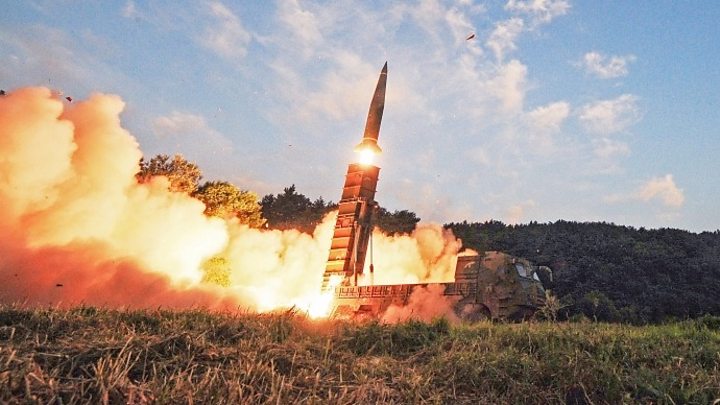
Media captionHow would war with North Korea unfold?
-
Pyongyang has been developing weapons, initially based on the Soviet-developed Scud, for decades
-
Conducted short and medium-range missile tests on many occasions, sometimes to mark domestic events or periods of regional tension
-
Pace of tests has increased in recent months; experts say North Korea appears to be making significant advances towards building a reliable long-range nuclear-capable weapon
-
On 3 September, North Korea said it tested a hydrogen bomb that could be miniaturised and loaded on a long-range missile


